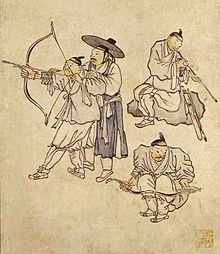Manggeon
| Manggeon | |
 All men show their manggeon on the head. The man in blue clothing wears his manggeon under gat. | |
| Korean name | |
|---|---|
| Hangul | 망건 |
| Hanja | 網巾 |
| Revised Romanization | manggeon |
| McCune–Reischauer | mangkŏn |

Manggeon or Wangjin is a kind of traditional Korea and Chinese headband worn by men to hold their hair in place after the topknot is done. It is usually made by weaving dyed horsehair. In Korea, Artisans who specialize in making manggeon are called manggeonjang (망건장).[1][2][3][4][5][6]
History
According to the earliest people who wore Wangjin were the Daoshi. One day, The Hongwu Emperor of Ming Dynasty wore common clothes to visit the folk and he saw a Daoshi wore Wangjin on top of his head. The Emperor asked the Daoshi what is it and then the Daoshi answered "This is Wangjin, wear it on top of your head, then your hair will gather together"「此曰網巾。裹以頭,則萬髮俱齊。」. The Emperor was really satisfied with this answer that contained meaning of united the country. After the Emperor returned to his palace, he ordered that all the men in the country must wear Wangjin on their head. Afterwards it spreads to Korea and it became the Manggeon in Korea.
See also
References
- ↑ "Important Intangible Cultural Properties 66". Cultural Heritage Administration.
- ↑ http://www.korea.net/kois/magazine/pictorialKoreaView.asp?Html_no=179
- ↑ 망건 (網巾) (in Korean). Empas / EncyKorea. Retrieved 2008-09-21.
- ↑ 망건장 (網巾匠) (in Korean). Empas / EncyKorea. Retrieved 2008-09-21.
- ↑ 망건 (網巾) (in Korean). Doosan Encyclopedia. Retrieved 2008-09-21.
- ↑ 망건장 (網巾匠) (in Korean). Doosan Encyclopedia. Retrieved 2008-09-21.
External links
| Wikimedia Commons has media related to Manggeon. |